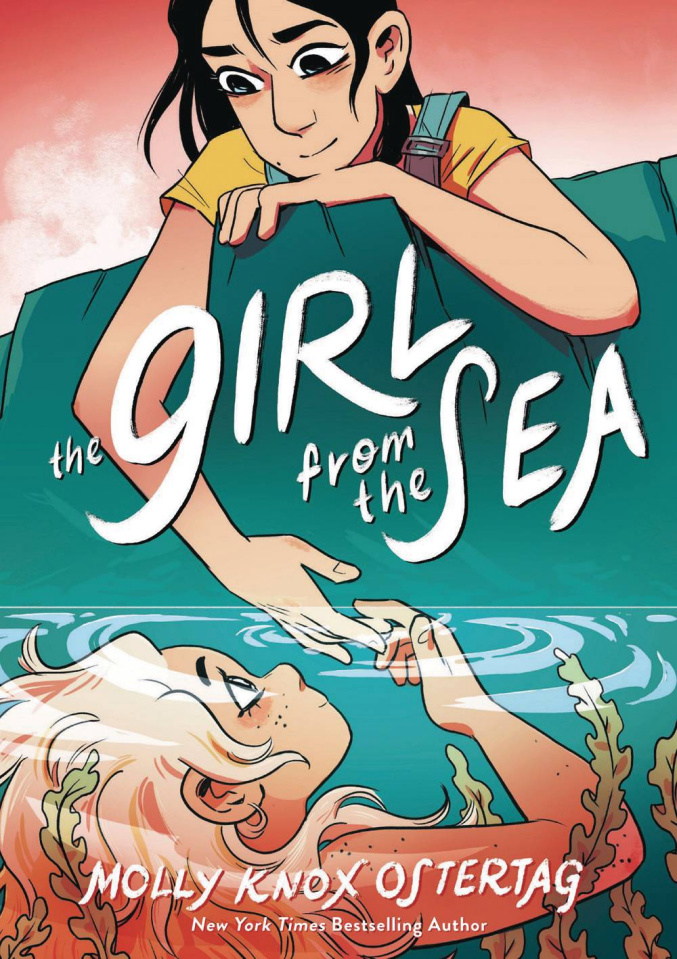Review of Girl from the Sea
Scholastic Inc. 2021. 256 pages.
There’s been a recent surge of LGBTQ+ centred stories for younger readers. Some include Heartstopper by Alice Oseman and Mooncakes by Wendy Xu and Suzanne Walker, both of which I’m happy to have on my shelf. Molly Knox Ostertag joins these authors once again with her latest queer coming-of-age graphic novel, The Girl from the Sea, which blends the sweetness and tragedy of young love through its pastel tones and magical elements.
The Girl from the Sea follows Morgan Kwon, a fifteen-year-old girl living in a small island town. She’s silently dealing with her parents’ recent separation, a bratty little brother, strained friendships, and her own closeted gay feelings. Her already chaotic life gets upended by the arrival of Keltie, a local selkie who Morgan kissed once and is now proclaiming to be her true love. Keltie’s presence sets Morgan on a journey to confront her feelings and fears, all with the magical subplot of Keltie’s seal family being put in danger by human environmental damage. The girls are forced to learn and grow by being together, because sometimes you need a bit of a push to find yourself.
Morgan as a character is very interesting. She divides her life and herself into neat categories, similar to many other queer people, myself included. She’s a perfect daughter to her single mom, an unassuming teenager to her friends, and a happy girlfriend to Keltie. Keeping these parts of her life separate keeps Morgan from confronting any issues in her life, something all too common with young queer people. We obsessively organize our whole lives to make staying in the closet reasonable. I started using a new name with my friends three years before I told my very liberal parents because I didn’t want to have that conversation. In turn, Morgan keeps her sexuality a secret because she doesn’t want her friends to see her differently and to cause her mother more stress. But Keltie’s presence and Morgan’s intense feelings for her forces her to understand who she really is. It’s about finding that person who makes you want to live better and to step outside your shell, like I found in my friends.
Keltie, on the other hand, has seemingly never taken responsibility before. As readers, we see her attempt to navigate through both her duties and feelings, something many teenagers and even some adults can relate to. Going to the surface is her first big mission for her seal family whom she, as the selkie born to her generation, is expected to protect. She would love nothing more than to just eat “land people food” and be with Morgan. But the local human expansion is harming the people (or the seals, I suppose) that she loves. Choosing between happiness and responsibility is something many struggle with, especially as they grow older. Ostertag uses magical realism to explore a very down-to-earth topic.
Art plays a very important role in the story, as with any good comic. Most scenes are set in pastel colours — bright blue skies, emerald green hills, white sand — all unrealistic but beautiful. In contrast, Ostertag’s previous series, The Witch Boy, had a darker colour scheme. Most scenes were desaturated with occasional sharp colours to convey intensity. That was because Witch Boy, while being a kids’ book, was heavily influenced by horror elements where the story and its imagery were narratively much darker. Ostertag shows her range and understanding of the comic art form in The Girl from the Sea. The soft tones convey that this story is essentially a modern fairy tale, what with Keltie’s grand quest, the epic love story, and the moral of learning to grow up. Ostertag also shows her brilliance in writing by using fairy tale-esque colours to have readers assume certain ideas and tropes would be present, then turning those on their head. Keltie and Morgan’s romance isn’t perfectly magical; they have their problems. The idyllic town isn’t all bright and wonderful. Ostertag plays with our assumptions through her art, showing her understanding of visual media and how to use it in interesting ways.
My only critique of this book is more personal than objective. I’m not a fan of tragic, queer romances. We’ve had many of those over the years and it’s gotten old. Queer people are seemingly never allowed to be happily together the way mainstream heterosexual couples are. However, I see what Ostertag was aiming for with Morgan and Keltie’s romance. In reality, most teenage relationships don’t last very long, but that doesn’t make them meaningless. The two girls changed each other’s lives for the better in the end. In spite of the pain, Morgan is grateful for having Keltie in her life. It’s a touching and important message in today’s teen romance market, which tends to heavily lean on the “one and only true love” storyline, prioritizing that one person, while vilifying “failed” relationships. Despite being another queer tragedy, this is actually a refreshing take on teen romance. I think it does show a lot of growth in the queer romance genre, where we can have a relationship that doesn’t end with homophobia or death, but rather the inevitability of young love ending. Even if it’s not some people’s cup of tea, it’s a good step forward.
Overall, this book is about growing up. Both girls are at the very edge of young adulthood and being together gives them the push to learn and change. It truly is a modern version of old fairy or folk tales — with the wonder and magic of ancient stories, combined with current day life lessons and tragedies. Ostertag proves to me once again that she can tap into deep emotions and queer experiences very well. I thoroughly enjoyed this book. I’m happy to put it next to my Witch Boy trilogy, and I look forward to Ostertag’s next work.

